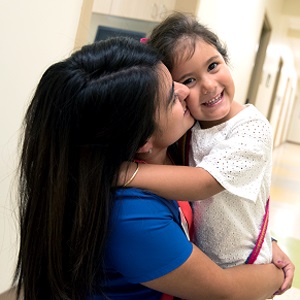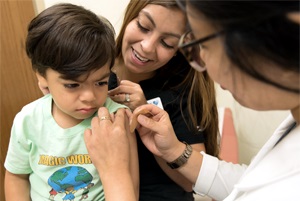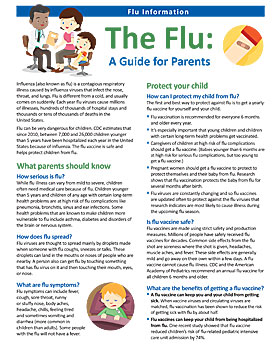Children & Influenza (Flu)
Children younger than 5 years of age –especially those younger than 2 years old– are at high risk of serious flu-related complications. A flu vaccine offers the best defense against getting flu and spreading it to others. Getting vaccinated can reduce flu illnesses, doctor’s visits, missed work and school days, and prevent flu-related hospitalizations and deaths in children. Information on this page summarizes vaccine recommendations for children. Visit this page to learn more about vaccine benefits.
What Parents Need to Know About Flu

Flu is more dangerous than the common cold for children. Each year flu places a large burden on the health and well-being of children and their families.
Influenza is dangerous for children
Flu illness is more dangerous than the common cold for children. Each year, millions of children get sick with seasonal flu; thousands of children are hospitalized and some children die from flu. Children commonly need medical care because of flu, especially children younger than 5 years old who become sick with flu.
- Complications from flu among children in this age group can include:
- Pneumonia: an illness where the lungs get infected and inflamed
- Dehydration: when a child’s body loses too much water and salts, often because fluid losses are greater than from fluid intake)
- Worsening of long-term medical problems like heart disease or asthma
- Brain dysfunction such as encephalopathy
- Sinus problems and ear infections
- In rare cases, flu complications can lead to death.
- Flu seasons vary in severity, however every year children are at risk
- CDC estimates that since 2010, flu-related hospitalizations among children younger than 5 years ranged from 7,000 to 26,000 in the United States.
- While relatively rare, some children die from flu each year. Since 2004-2005, flu-related deaths in children reported to CDC during regular flu seasons have ranged from 37 deaths to 185 deaths. Information about pediatric deaths since the 2004-2005 flu season is available in the interactive pediatric death web application.
Some children are at especially high risk
Children at greatest risk of serious flu-related complications include the following:
- Children younger than 6 months old
These children are too young to be vaccinated. The best way to protect them is to make sure people around them are vaccinated. - Children aged 6 months up to their 5th birthday
Since 2010, CDC estimates that flu-related hospitalizations among children younger than 5 years ranged from 7,000 to 26,000 in the United States. Even children in this age group who are otherwise healthy are at risk simply because of their age. Additionally, children 2 years of age up to their 5thbirthday are more likely than healthy older children to be taken to a doctor, an urgent care center, or the emergency room because of flu1,2,3. To protect their health, all children 6 months and older should be vaccinated against flu each year. Vaccinating young children, their families, and other caregivers can also help protect them from getting sick. - American Indian and Alaskan Native children
These children are more likely to have severe flu illness that results in hospitalization or death.4,5 - Children aged 6 months through 18 years with chronic health problems, including:
- Asthma
- Neurological and neurodevelopmental conditions [including disorders of the brain, spinal cord, peripheral nerve, and muscle such as cerebral palsy, epilepsy (seizure disorders), stroke, intellectual disability (mental retardation), moderate to severe developmental delay, muscular dystrophy, or spinal cord injury]
- Chronic lung disease (such as chronic obstructive pulmonary disease [COPD] and cystic fibrosis)
- Heart disease (such as congenital heart disease, congestive heart failure and coronary artery disease)
- Blood disorders (such as sickle cell disease)
- Endocrine disorders (such as diabetes mellitus)
- Kidney disorders
- Liver disorders
- Metabolic disorders (such as inherited metabolic disorders and mitochondrial disorders)
- Weakened immune system due to disease or medication (such as people with HIV or AIDS, or cancer, or those on chronic steroids)
- Children who are taking aspirin or salicylate-containing medicines
- Children with extreme obesity (body mass index [BMI] of 40 or more) Calculate your Body Mass Index or BMI, here
Vaccination is the best protection against flu
Note: See Frequently Asked Flu Questions 2018-2019 Influenza Season for flu and flu vaccine information specific to the current flu season.

The best way to prevent flu is with a flu vaccine. CDC recommends that everyone 6 months of age and older get a seasonal flu vaccine each year by the end of October. However, as long as flu viruses are circulating, vaccination should continue throughout flu season, even in January or later. Keep in mind that vaccination is especially important for certain people who are high risk or who are in close contact with high risk persons. This includes children at high risk for developing complications from flu illness, and adults who are close contacts of those children.
Flu vaccines are updated each season if necessary to protect against the influenza viruses that research indicates will be most common during the upcoming season. (See Vaccine Virus Selection for this season’s exact vaccine composition.) The 2018-2019 vaccine has been updated from last season’s vaccine to better match circulating viruses. Immunity from vaccination sets in after about two weeks.
Types of flu vaccines for children
Children 6 months and older should get an annual influenza (flu) vaccine. For the 2018-2019 flu season, CDC recommends annual influenza vaccination for everyone 6 months and older with any licensed, age-appropriate flu vaccine (IIV for children aged 6 months and older or LAIV4 for children 2 years of age and older) with no preference expressed for any one vaccine over another.
- Flu shots (IIV), vaccines given as an injection and made with inactivated (killed) flu virus are approved for use in people 6 months and older.
- The nasal spray vaccine (LAIV4) is approved for use in people 2 through 49 years of age. However, there is a precaution against the use of nasal spray flu vaccine (LAIV) in people with certain underlying medical conditions. More information about the nasal spray flu vaccine can be found here.
Your child’s health care provider will know which vaccines are right for your child.
For more information on the different types of flu vaccines available visit CDC’s Different Types of Flu Vaccines page.
Special vaccination instructions for children aged 6 months through 8 years of age
- Some children 6 months through 8 years of age require two doses of influenza vaccine. Children 6 months through 8 years getting vaccinated for the first time, and those who have only previously gotten one dose of vaccine, should get two doses of vaccine this season. All children who have previously gotten two doses of vaccine (at any time) only need one dose of vaccine this season. The first dose should be given as soon as vaccine becomes available.
- The second dose should be given at least 28 days after the first dose.The first dose “primes” the immune system; the second dose provides immune protection. Children who only get one dose but need two doses can have reduced or no protection from a single dose of flu vaccine.
- If your child needs the two doses, begin the process early.This will ensure that your child is protected before influenza starts circulating in your community.
- Be sure to get your child a second dose if he or she needs one.It usually takes about two weeks after the second dose for protection to begin.
Children should be vaccinated every flu season
Children should be vaccinated every flu season for the best protection against flu. For children who will need two doses of flu vaccine, the first dose should be given as early in the season as possible. For other children, it is good practice to get them vaccinated by the end of October. However, getting vaccinated later can still be protective, as long as flu viruses are circulating. While seasonal influenza outbreaks can happen as early as October, in most seasons influenza activity peaks between December and February. Since it takes about two weeks after vaccination for antibodies to develop in the body that protect against influenza virus infection, it is best that people get vaccinated so they are protected before influenza begins spreading in their community.
Additional Information:
Video
Factsheet
Additional Resources for Parents and Caregivers
Additional Information
Communication Resources
For Health Care Professionals
- Figure. Influenza vaccine dosing algorithm for children aged 6 months through 8 years
- 2018-19 Summary of Flu Vaccine Recommendations
- CDC Reports About 90 Percent of Children Who Died From Flu This Season Not Vaccinated March 22, 2013
- Children with Neurologic Disorders at High Risk of Death from Flu August 29, 2012
- CDC Report Details Influenza Prevention and Treatment for Children and Teens September 15, 2011
Children at High Risk of Serious Flu-Related Complications
1CDC Report: CDC Influenza Vaccine Program Impact Report 2015-2016
2Study: Influenza and Other Respiratory Virus–Related Emergency Department Visits Among Young Children. Pediatrics. 2006
3Study: The Underrecognized Burden of Influenza in Young Children. New England Journal of Medicine. 2006
4MMWR: Deaths Related to 2009 Pandemic Influenza A (H1N1) Among American Indian/Alaska Natives — 12 States, 2009
5MMWR: Prevention and Control of Influenza with Vaccines: Recommendations of the Advisory Committee on Immunization Practices (ACIP), 2010
- Page last reviewed: November 8, 2018
- Page last updated: November 8, 2018
- Content source:
- Centers for Disease Control and Prevention, National Center for Immunization and Respiratory Diseases (NCIRD)
- Page maintained by: Office of the Associate Director for Communication, Digital Media Branch, Division of Public Affairs



 ShareCompartir
ShareCompartir
